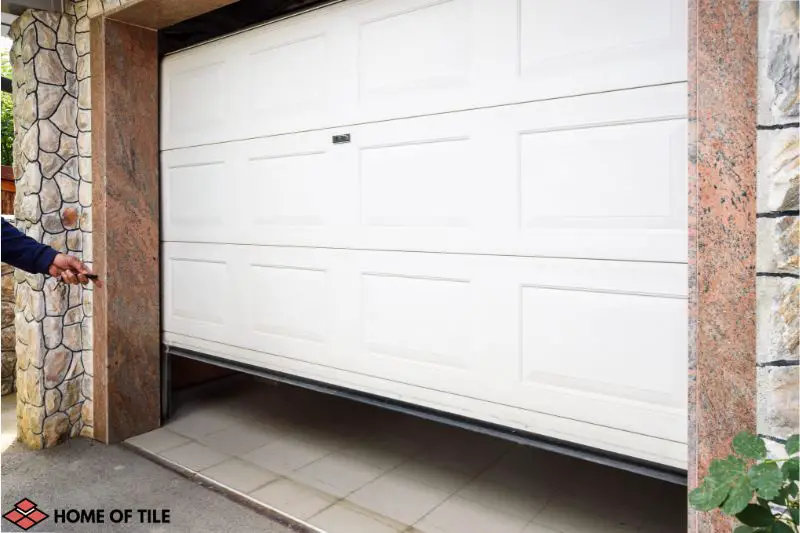How Many Garage Tiles Do I Need? 6 Things You Should Know
Tiling your garage allows you to keep the space structurally sound and safe from the elements. However, if you’ve never done this project before, you may be wondering how to calculate the number of tiles you’ll need.
How many garage tiles you’ll need will depend on the size and shape of your garage as well as the shape and size of the tiles you’re installing. Generally, you need to divide the width of the floor by the width of the tiles. Repeat the same process with length, and multiply the two figures.

In the rest of this article, I’ll walk you through everything you need to know about choosing the right number of tiles for your garage, along with other things you’ll want to consider throughout the process. By the end of this, I guarantee you’ll be able to go to your local hardware store with confidence, knowing that you’re getting enough tiles to cover the entire space.
Contents
How Do I Calculate How Many Tiles I Need?
To calculate how many tiles you need, divide the width of the floor by the width of one tile and round up the result to the closest whole number. Repeat the same process with height and multiply the two figures together. The result is the number of tiles you need to cover a rectangular floor.
Follow these steps to make your calculations:
- Take note of the exact measurements (width and length) of the garage tiles you want to use.
- Measure the width and length of the floor you’re working on, and take note of these numbers as well.
- Divide the floor’s width by the width of one individual tile. The result is the number of tiles you’ll need to install along the width of the floor. If you don’t get a whole number, always make sure to round up rather than down.
- Divide the floor’s length by the length of one individual tile. Multiply the result by the number of tiles you calculated in Step 3.
If you’re looking to tile the garage’s walls as well, remember that you’ll have to repeat the process with at least two of the walls. Considering that most rooms are cuboid-shaped, only measuring the number of tiles you need to cover two of the walls and then multiplying that figure by two should do the trick.
If you’re not a big math fan, you can always forgo the trouble by using an online calculator that does most of the work for you. All you have to do is input the measurements of the tiles you’re using and those of the space you’re looking to cover, and the calculator automatically comes up with the right number of tiles you’ll need.
Now that you have a better idea of how to accurately estimate the number of tiles you’ll need for your project, let’s quickly discuss three important factors to keep in mind along the way.
What You Need To Know About Garage Tiles
Installing garage tiles offers a way to spruce up your space while also protecting it from wear and tear. If you’ve been thinking about adding garage tiles to your home, here are some things you need to know.
● Garage Tiles Come in Different Shapes and Sizes
Garage tiles come in a wide array of materials, shapes, and sizes, and you’ll want to take all three into consideration during the calculation process.
- Different materials offer different benefits: Natural stone is attractive and more resistant to wear and tear, while vinyl has a more modern look.
- Shape matters: Smaller tiles can create intricate patterns but may be more difficult to install.
- With size comes cost: Larger tiles tend to be more expensive than smaller ones.
Knowing the right type of tiles needed will help you determine how much coverage you’ll get from each tile box as well as the overall costs for your project.
● It’s Important To Consider the Shape of Your Garage
Just like tiles, garages come in different shapes and sizes, too. Some are large enough to fit two cars, while others may just have enough space for one vehicle. Since they were never meant to be an actual room, these spaces can sometimes be very oddly-shaped, which can complicate your measurements.
If this is the case, you’ll want to divide the area into smaller, regularly-shaped sections, measure the tiles needed to cover each section and add everything together.
● It’s Better To Overestimate Than Underestimate
Throughout this piece, I’ve mentioned rounding up your calculations a couple of times, and “up” is the operative word here. If you’re tiling your garage for the first time, it’s normal to make some errors in your calculations; however, it’s always better to err on the side of safety and get more tiles than needed rather than fewer.
How Many Boxes of Tile Do I Need for 100 Square Feet?
Once you actually get to the hardware store, though, you’ll notice that most tile varieties aren’t sold separately. Instead, they’re pre-packaged in boxes, so how can you know how many boxes you’ll need?
To calculate how many boxes of tiles you need for 100 square feet (9.3 sq m), you need to know how many tiles you need overall and how many tiles each box holds. However, considering that most tile boxes hold around 10 square feet (0.93 sq m) worth of tiles, you’ll likely need 10 of them.
However, keep in mind that this is a generalization and that this won’t apply to every tiling project. That’s why it’s best to take the time and calculate the exact number of tiles you’ll need.
To do so, take the total number of tiles calculated in the section above and divide it by the number of units held by each box of your preferred tile model. The number you get is the number of boxes you’ll need.
Conclusion
There you have it—everything you need to know about calculating the number of tiles you’ll need for your garage. By following the above tips, you’ll be able to take accurate measurements that’ll make the tiling process go that much smoother. For optimal insulation, I also recommend coating your garage tiling.







